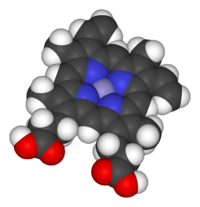
Photo from wikipedia
This experiment was conducted to evaluate the effects of heme and non-heme iron sources on growth performances, blood parameters, tissue mineral concentration, and intestinal morphology in weanling pigs. At 25 days… Click to show full abstract
This experiment was conducted to evaluate the effects of heme and non-heme iron sources on growth performances, blood parameters, tissue mineral concentration, and intestinal morphology in weanling pigs. At 25 days of age, 32 newly weaned piglets (Duroc × Landrace × Yorkshire; 8.66 ± 0.59 kg) were allocated to one of the following dietary treatments: control group (basal diet with no extra iron addition), FeSO4 group (basal diet + 100 mg Fe/kg as FeSO4), Fe-Gly group (basal diet + 100 mg Fe/kg as Fe-Gly), and Heme group (basal diet + 100 mg Fe/kg as Heme). Each treatment had eight replicates and one pig per replicate. The experiment lasted for 28 days. The results showed that compared with basal diet, supplement with 100 mg/kg iron can increase ADG of the piglets, especially in the late experiment period (15~28 days). Heme significantly increased the a* value of longissimus dorsi muscle of piglets when compared with other iron sources (P < 0.05). The iron supplementations had no significant effect on hematological parameters, while Fe-Gly and heme increased pigs’ serum iron content on day 28 when compared with FeSO4 and basal diet (P < 0.05). The liver iron deposition in pigs fed Fe-Gly and heme was also higher than those fed FeSO4 or basal diet (P < 0.05). Besides, diet supplement with iron significantly increased villus height (P < 0.05) in duodenum and it had tendency to increase villus height and crypt depth ratio in duodenum (P = 0.095). In conclusion, iron supplementation in diets can improve piglet’s body iron state and intestinal development, but Fe-Gly and heme exhibited better bioavailability than traditional additive of FeSO4.
Journal Title: Biological Trace Element Research
Year Published: 2018
Link to full text (if available)
Share on Social Media: Sign Up to like & get
recommendations!